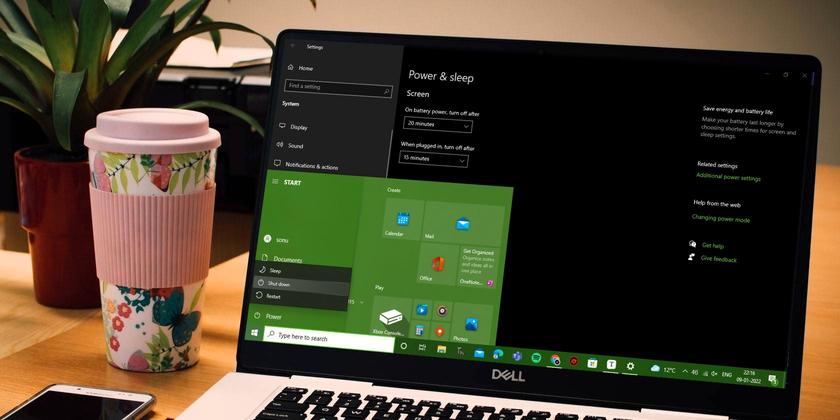
www.makeuseof.com Should You Shut Down Your Mac or Put It to Sleep?
Should you shut down your Mac or put it to sleep? This is one of the most common questions you might hear from a Mac user.
Many people have no qualms about keeping their devices in idle or sleep mode when leaving them for a few minutes or hours. But most people who ask this question are deciding what to do when leaving their Mac for a day or two, or even more.
To put you out of your misery, the short answer to this question is that it’s almosr always better to put your Mac to sleep. Here are four reasons why.
1. Your Mac Can Accomplish More Asleep
When a Mac is in sleep mode, it automatically uses a feature called Power Nap that allows it to wake up every now and then to sync your devices and update the Mail, Calendar, Notes, Photos, and Contacts apps along with iCloud Documents. It also updates your location for Find My Mac, a beneficial feature should your device go missing.
When plugged into a power source, your Mac can do even more with Power Nap, like update your computer’s software and schedule Time Machine backups.
Related: Here’s What Power Nap Does on a Mac and How to Enable or Disable It
Note that while Intel Macs give you the option to turn Power Nap off, Macs running on M1 chips have an always-on processor, integrating Power Nap features in the system’s natural behavior. This means that there is no option to turn functions like automatic syncing off.
2. You Can Resume Tasks Instantly
A Mac put in sleep mode can be woken instantly and allows you to jump back where you left off. You’ll see your Mac light up as soon as you open the lid or touch the trackpad if you’re using a MacBook, or after you touch any key or move the Magic Mouse if you’re using an iMac.
MAKEUSEOF VIDEO OF THE DAYIn contrast, if you shut down your Mac, it will close all running programs and applications. This means that when you start your Mac again, you need to reopen all these apps and programs one by one.

That is unless you’ve you’ve enabled it to reopen all the windows previously opened before you shut it down. To do this, just tick the box beside Reopen windows when logging back in on the prompt that appears before you shut down or restart your Mac. But even if you do this, it would take your Mac some time to reload all these apps.
3. The Energy Savings From Shutting Down Are Minimal
People don’t like putting their Macs to sleep because of the fear of high energy consumption.
However, Macs consume little energy when they’re in sleep mode. For example, an M1 Mac only consumes 0.18W per hour when in sleep mode, while a 27-inch Mac with Retina 5K display consumes only about 1.44W in an hour.
In comparison, your Mac consumes much more power when left idle. An M1 Mac in idle consumes 3.22W an hour while a 27-inch Mac with Retina 5K display consumes 31.1W. It may even consume more when you shut it down and start it again. This is because it takes more energy to boot a device up.
More importantly, your Mac uses next to no power as it performs its maintenance tasks while on sleep mode. Thus, keeping it in sleep mode to run maintenance tasks should not be a cause for concern.
4. Sleep Mode Doesn’t Wear Down a Mac
Back in the day, computers used many mechanical parts like hard disk drives (HDD). This is why many people opted to shut their devices down than allow the machines to continue running, which can wear them down.
However, Macs and most modern laptops have replaced HDDs with solid-state drives (SSDs), which are more like chips than disks. Since SSDs do not have physical moving parts, they’re less likely to wear. They’re also faster and hold more storage. So keeping them running occasionally while in sleep mode is no longer a problem.
When Is It a Good Option to Shut Down a Mac Instead of Putting It to Sleep?
Shutting down your Mac can be beneficial at times. Turning it off completely allows your computer to detect problems and issues so that it can run much smoother the next time you use it.
This is why restarting or shutting down a Mac is the first response you should take when your Mac is acting up, slowing down, or showing other problems. Restarting your Mac once a week or even once a month can help catch these issues early.
It’s also best to shut down your Mac if you don’t plan to use it for a longer period of time, say more than a week. Shutting down also allows your machine to cool down if it’s overheating.
Related: How to Make Your Mac Boot Up, Sleep, or Shut Down Automatically
If you plan to store your Mac for a long time, it’s crucial to drain it to 50% before shutting it down to maintain its battery health. Ensure that you keep it in a moisture-free environment that’s less than 32°C without getting too cold. If you plan to store it longer, top up the battery charge to 50% every six months.
Sleep Is a Better Option Than Shutting Down
Shutting down your Mac and putting it in sleep mode both offer benefits to your Mac. However, if the question is which one is better for daily use—that is, if you only plan to stop using your Mac for a few hours or for the night—then putting your Mac to sleep is the best option.
This battery saving mode does more for your Mac than when you shut it down. It also saves you time, allowing you to use your Mac almost instantaneously, having saved the windows you were in so you can jump right back where you left off.
10 Ways to Improve Your MacBook’s Battery Life Read NextShareTweetShareEmail Related TopicsAbout The AuthorRachel Melegrito(156 Articles Published)Rachel Melegrito left her career as a university instructor to become a full-fledged content writer. She loves anything Apple —from iPhones, to Apple Watches, to MacBooks. She is also a licensed occupational therapist and a budding SEO strategist.
MoreFrom Rachel MelegritoJoin our newsletter for tech tips, reviews, free ebooks, and exclusive deals!
}})